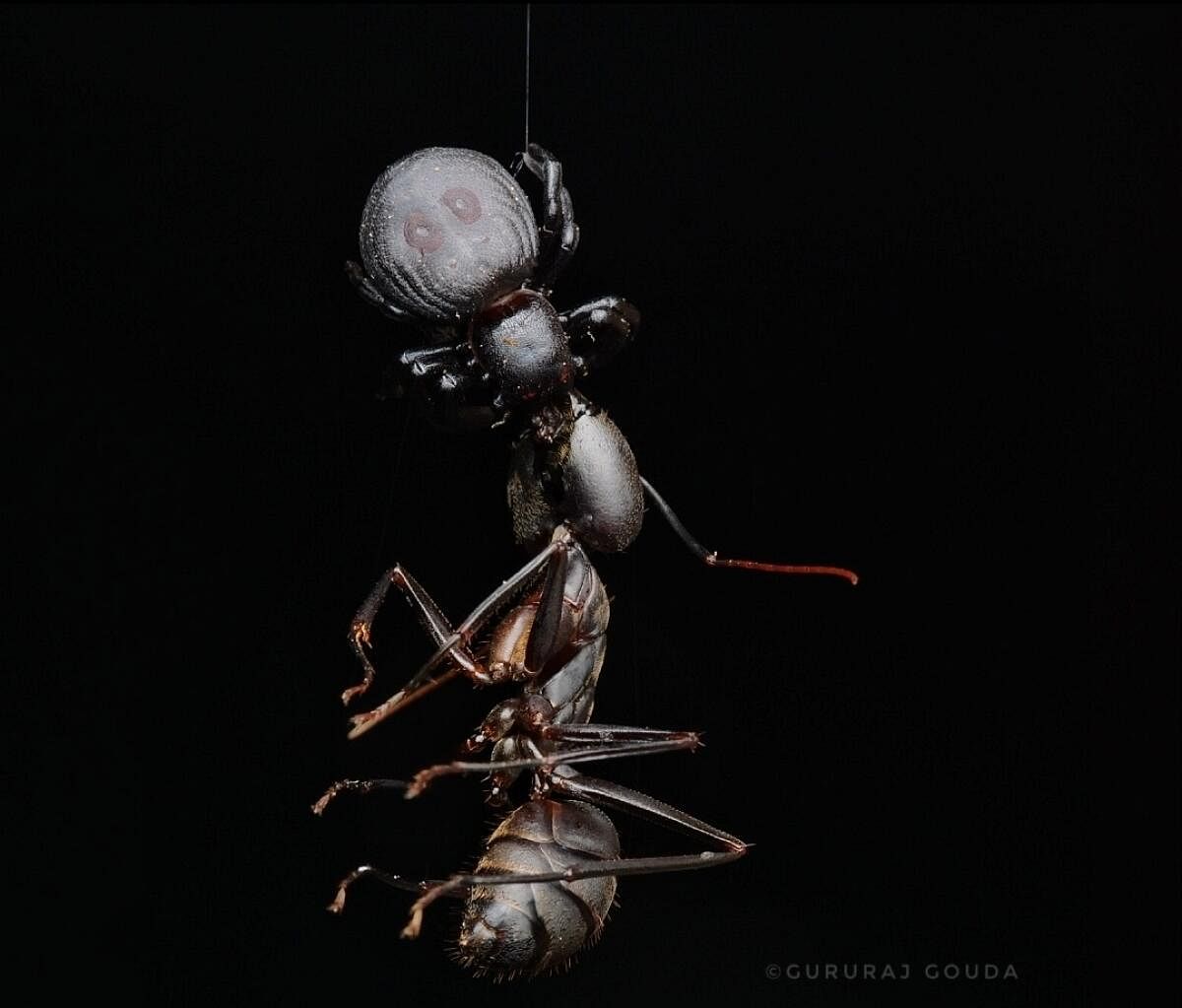
At the end of the day, when darkness sets in and human activities, including safaris, fall silent at the Kali Tiger Reserve (KTR) in Uttara Kannada, 30-year-old Gururaj Gouda gets to work. Equipped with a head torch, a camera bag with a macro lens and diffusers, a water bottle and some biscuits, Gururaj begins to look for spiders. Pointing towards the forest floor where a spider lay waiting for its prey, he says, “These are wolf spiders which carry their spiderlings on their back. Unlike others, they do not spin a web to hunt prey and instead hunt their prey just like wolves.” He swiftly takes several pictures of its intense eyes and agile body from different angles.
Gururaj explains that KTR is home to some amazing and rare spider species, as it has diverse habitats — evergreen, deciduous, semi-deciduous and grassland patches along with streams, rock and road patches. His eyes continue to sweep the surroundings for more of these commonly-feared arachnids.
“A natural habitat is said to be healthy if there are six spiders in one square metre. Or else, it tells us humans have destroyed the habitat,” he explains, while observing a lichen huntsman spider guarding her egg sac.
For the last six to seven years, Gururaj, a deputy range forest officer, has been documenting the spiders in KTR.
A postgraduate in mathematics, he had a keen interest in birds, insects and spiders since childhood and began working on spiders when he was a trainee with the Forest Department. Once he came to KTR, he began documenting spiders out of passion and even drew some others towards understanding spiders.
Web of impact
As a result, around 242 species of spiders from 38 families have been documented in KTR until now.
“Most people still think that spiders are insects and fear them. In fact, spiders are insect-eaters and bio-indicators. If there were no spiders, we would have insects all around. That is why we need to study spiders and conserve them,” says Prasanna Parab, a spider enthusiast studying the spiders of north Karnataka and Goa.
Until now, Gururaj and his team have documented several rare and interesting spiders in KTR. This includes the colourful signature spiders known for their typical zig-zag web patterns, crab spiders that move sideways or backwards, the steatoda (a cousin of the black widow) with black and white patterns on abdomen sides, spiders that mimic weaver ants, the Tropazodium kalami named after Dr A P J Abdul Kalam, the golden orb-web spiders which build golden webs, to name a few. Other distinctive species include the Marengo sachintendulkar, a jumping spider named after Sachin Tendulkar, tarantulas like the lesser Goa mustard, the Indian violent, Mysore ornamental, the Idiops joida that lives in a burrow with a door and venomous spiders like the redback spider.
Tough task
However, documenting spiders in the forest of the Western Ghats comes with its own challenges.
For at least four days a week, Gururaj completes his duty as a forest guard at the rehabilitation and relocation department by 5 pm. Three hours later, along with some of his colleagues like Ankush, a computer operator with the department, Gururaj gets into the forest to observe the spiders that are mostly nocturnal.
“We are here till 1 or 2 am observing the spiders’ habitat, feeding patterns, courtship and mating behaviour. In fact, we are here till our camera’s battery gets exhausted,” chuckles Gururaj.
Once back home, he share the pictures with naturalists and spider enthusiasts associated with the Karnataka Spider Club to confirm the species. He also discusses his finds with his brother, Mutturaj Gouda, a zoology student. It is only then that he is done for the day.
Collaborating, learning
There are others like Abhijeet A P C, founder of ‘Saaliga’, a group that has also been documenting spiders in Karnataka, and Chinmay Maliye, who help Gururaj’s team understand more about spiders. Ask him about conserving these creatures and Abhijeet says, “We cannot conserve spiders like we conserve tigers or other animals, as they are small and have garmented habitation. But spiders come under the umbrella species of these animals and conserving these bigger animals will help the spiders as well.”
Parab adds that conservation is needed, as some spider species are under threat. “It is an open secret that some spiders like tarantulas are traded illegally. They are kept as pets or used in religious rituals and it is difficult to have a ‘census’ on the number of spiders in the wild. Once traded, the species nearly disappears,” he says.
Gururaj also spends time creating awareness about the importance of spiders among students, forest department trainees and others through workshops.
Manoj Dodwad, a final year BSc student of the College of Forestry, Sirsi, has drawn inspiration from the ‘Spiderman of KTR’. “It was only after I attended a workshop on spiders that I realised that they are indicators of biodiversity and began identifying the species.” He learnt how to do this, by looking at the eye pattern. “Many of my seniors too began identifying the spiders on our campus,” Dodwad adds.
Maria Christu Raja, director of KTR, says this checklist of diverse spider species spotted in KTR will help further research on biodiversity and evolutionary phenomena. It also inspires other forest personnel to get involved in such work. The forest department is providing all the necessary support that Gururaj and his team need, including getting the required camera lenses and permissions for their research.
Gururaj further wants to document the mating behaviour of spiders and address the fear associated with these creatures.